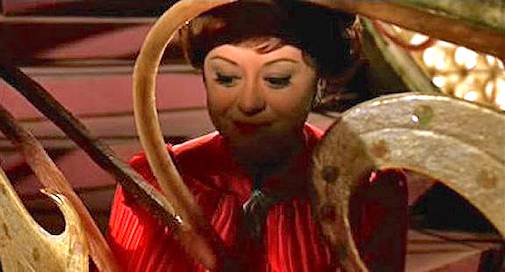"The Furniture," by Daniel Walber, is a series on Production Design.

This week we mark the centennial of actress Giulietta Masina, which I consider an opportunity to do something a little different. The Furniture, as you might expect, is rarely a column about performance. I spend a lot of time trying to get screenshots without any actors present at all. Production design often works in support of performance, or in parallel, but rarely are they what you might call intertwined.
In the films of Federico Fellini, Masina’s husband and collaborator, design often threatens to overwhelm or absorb performance. Actors become moving props in his most extravagant productions, rotating like carousel horses around a central figure or two. And these protagonists are often ciphers of style themselves, particularly when they’re played by Marcello Mastroianni.
Not so with 1965's Juliet of the Spirits. Masina is the well from which the entire production springs...
She plays a housewife marooned in a loveless marriage with a businessman named Giorgio (Mario Pisu). The film is a chronicle of her many investigations: of her husband’s infidelity, her mysterious neighbors, and her past. She becomes, essentially, her own medium.
It’s a quiet performance, built with the nuances of observation and body language. Movement, after all, is at the center of Masina’s art - she’s often compared to Charlie Chaplin, one of her fans.
Of course, this doesn’t mean that the Oscar nominated work of art director Piero Gherardi, set decorator Vito Anzalone and production designers Giantito Burchiellaro, Luciano Ricceri and Emanuele Taglietti is in any way restrained. Juliet encounters all sorts of dizzying interiors and open-air fantasies.
She ascends in wicker baskets and climbs curtained staircases. Her neighbor’s mansion is a funhouse of anonymous pleasures.
She experiences extravagant flashbacks to childhood, from her family’s circus to her convent school - which is its own sort of circus, in a Fellini film.
The ghost of Juliet as a child, strapped to a bed of iron and flame in a convent play, will become one of the adult Juliet’s most persistent hauntings.
The bizarre interiors are perfect backdrops for Masina’s measured and mannered presence, as she slowly takes in the implications of her surroundings. Restrained without ever coming across stiff or stoic, we observe Juliet’s gradual revelation in her eyes. Windows of the soul, etc.
But it is some actual windows which bring me back around the real design achievement of Juliet of the Spirits: Juliet’s home. The house is the physical incarnation of her spiritual condition, a domesticity-in-name-only that stands open to supernatural visitors and spiritual winds.
It’s like something out of a Rene Magritte painting, particularly when it’s lit up from the inside. The yard approaches the atmosphere of the artist’s “Empire of Light” series, outdoor lamps illuminating the perfectly trimmed bushes that line the path.
It is a house only in that it resembles a house. “Ceci n’est pas une maison,” if you will. It has none of the context of a house; there is no neighborhood, no street, no clear place in the world. It might as well be floating in space, or outside of time.
But this distance from reality does not imply inaccessibility. In nearly every shot there’s an open door or window, new guests brought in by every breeze. They seem to come from everywhere, bringing a variety of opinions, accents and moods. Some (all?) of them could be ghosts. It’s the perfect place for a seance, which is how the film begins.
Initially, most of the spirits that float through the doors are presented as entirely normal and expected, friends and family of Juliet and her husband. The waft about the house, taking full advantage of its beautifully-lit portals. Giorgio’s debonair colleague, a Spanish aristocrat played by José Luis de Vilallonga, elegantly slays an invisible bull by a curtained doorway.
It is a spiritual openness that mimics Masina’s open-faced performance, together weaving a portrait of Juliet’s open soul. Soon, her guests include not only her social circle but also her spiritual one. Ghosts of past and present file through the doors and windows, dozens of them.
An entire convent of purple nuns takes up residence in the living room.
The incarnation of martyred childhood slumps into the bathroom.
Juliet’s heightened spiritual sensitivity and the supernaturally welcoming character of her home are one and the same. The house is a visual extension of her mind, an architectural extension of her soul - and it’s no more a physical place than she is a real person.
At the same time, she is very nearly real. Masina is playing herself, or rather a version of it - much in the same way that Marstroianni plays a version of her husband in 8½. Juliet/Giulietta onscreen is an image of Juliet/Giulietta offscreen, though with the same unreality as Magritte and his pipe.
At the end of this parade of ghosts, the film’s version of Juliet seems to have wrapped up her investigations. Her ghosts take to the skies in their antique airplanes, assuring their hostess of a newfound clarity, if not exactly a conclusion. Finally, her house seems to be present on Earth.













